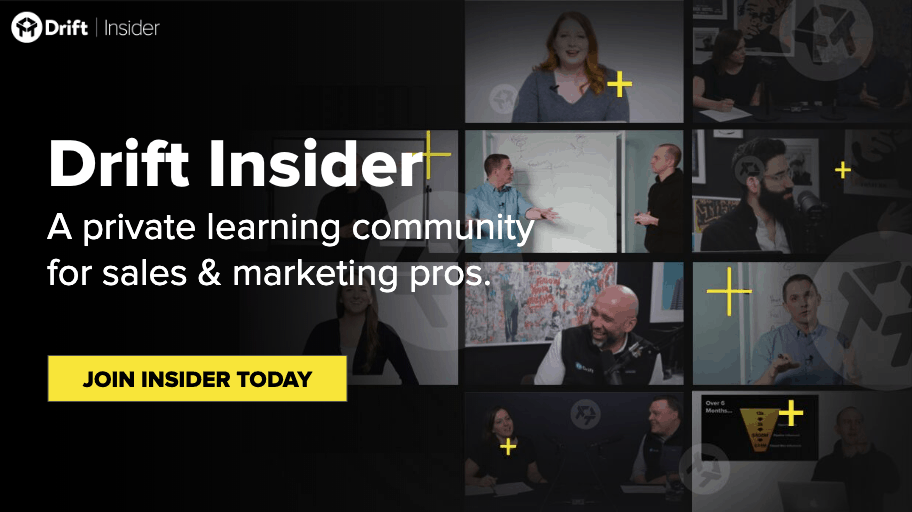
Each year, marketers crown a new channel the “king” of marketing ?
First it was email, then personalization, then content. Drumroll, please… according to the fifth edition of Salesforce’s State of Marketing Report, it’s customer experience.
Is a relentless focus on customer experience new? Not particularly. People have been talking about it as early as 2013. A quick Google search…
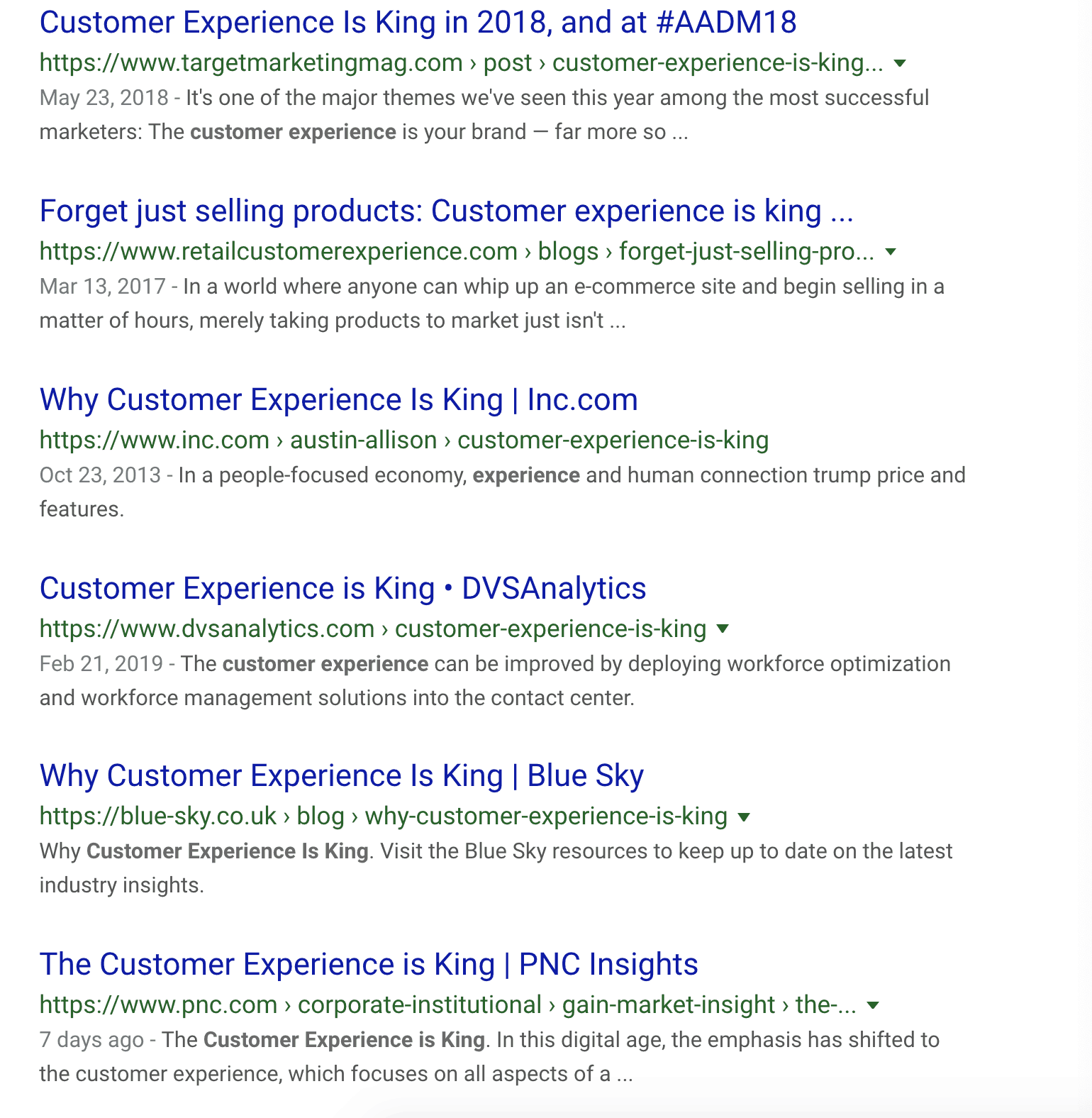
What the report shows is that a focus on customer experience is finally going mainstream. At Drift, we’ve recognized this shift and how critical it is to not only onboard and engage your customers, but to also ensure they are having the experience they expected across every touchpoint with your brand. To bring this to life, I’ve shifted my focus and am building the Customer Experience Team as part of Drift’s marketing organization.
Leaders are recognizing the responsibility of delivering a great customer experience isn’t a job executed only within customer support or customer success. It’s a fundamental part of your go-to-market strategy and a responsibility of your entire organization. In other words, customer experience is everyone’s job.
And that’s why I combed through all 58 pages of Salesforce’s State of Marketing Report to understand what over 4,100 marketing leaders had to say about how today’s marketers craft great customer experiences, their key challenges, and what you should expect in 2020. Here’s what I learned:
Marketers Build Experiences, Not Brands
Ok I know I just said this, but I’m going to say it again because it’s really, really important.
Your customer experience is your brand. 80% of customers say that the customer experience is as important as the product they’re purchasing.
Are you making it easy for your customers to buy from you?
Your customers demand to be treated like a human, not a number. In fact, 83% of B2B customers say being treated well is very important to winning their business.
A great customer experience is no longer a “nice-to-have.” And marketers are leading the way, with 54% of high performers leading customer experience initiatives across their business.
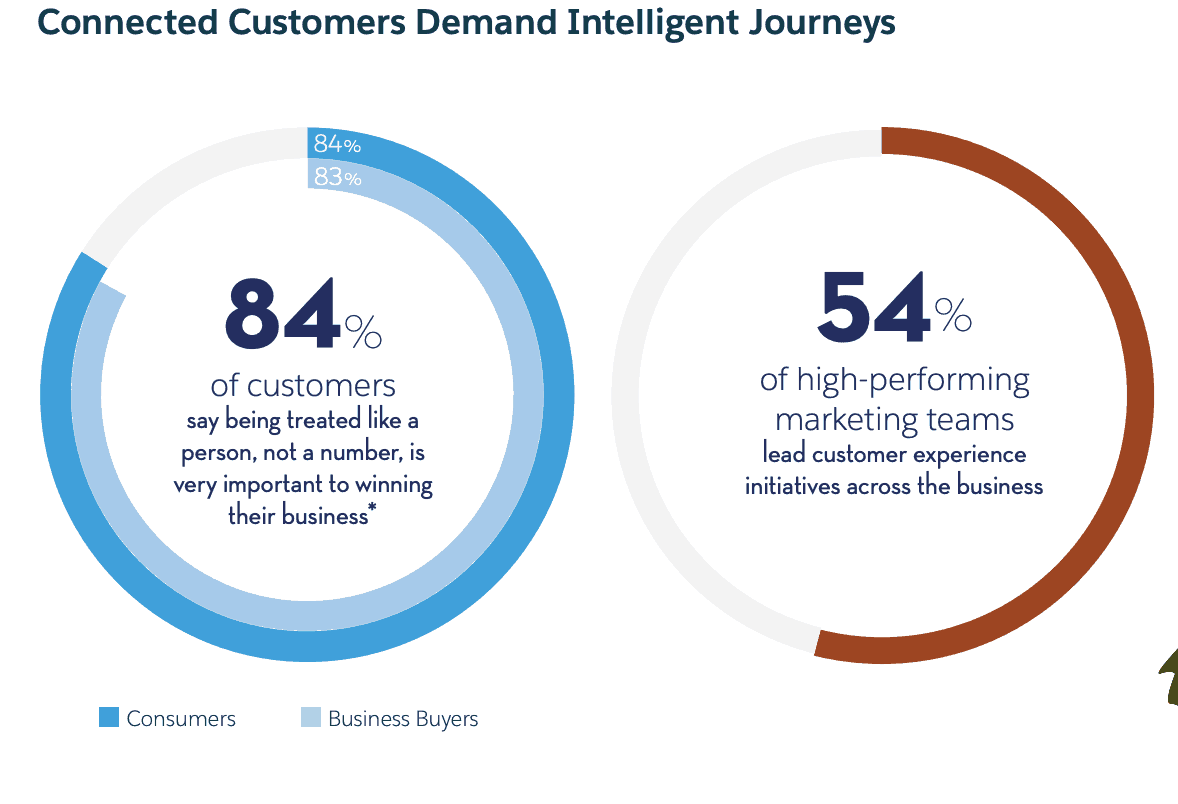
Today’s great marketers know that building a holistic customer experience matters more than getting your message or campaign out the door. Every single action you take should seek to help a customer’s goals, not just your own.
You’ve Only Got One Brand
Customers don’t see “marketing” or “sales” or “support” when they interact with you. They only see your brand, and the experience they have with it.
So as the ultimate protectors of the brand, marketers are much more likely to work cross-functionally than ever before.
In fact, 52% of marketers share goals with sales and 53% share goals with support – especially with the rise of self-service and what Salesforce calls “commerce” technology.
Marketers are the ones who connect the purchase path between thinking about an idea, researching it, and purchasing it. And while people have been talking about sales and marketing alignment for more than a decade it’s still something organizations struggle with.
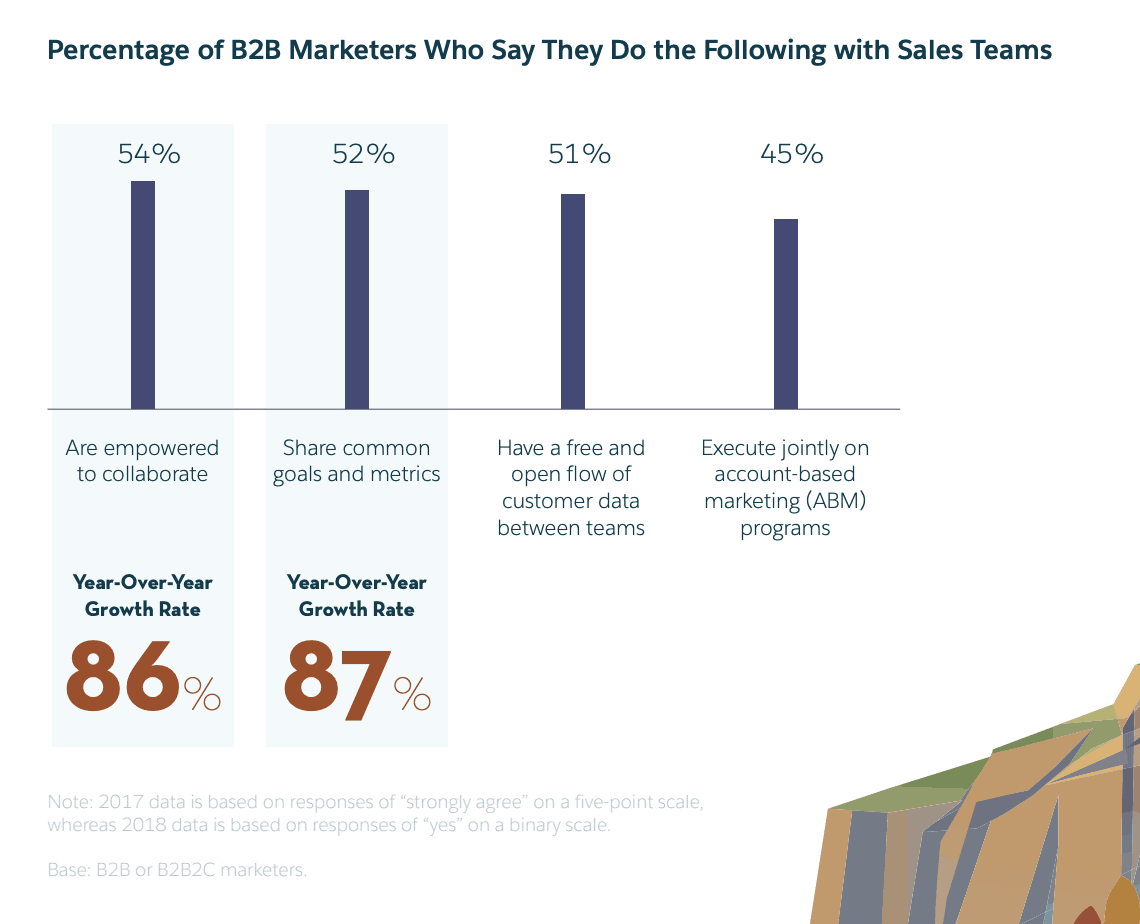
That’s changing, especially for high performing teams. The fastest-growing companies actively collaborate and share data with their sales teams, about 1.5x more likely than underperformers. 54% say they actively collaborate with sales, and 45% execute joint programs.
Marketers are also – surprise, surprise – closing the loop on retention, working more closely with support than ever. 60% of marketing teams track customer satisfaction and retention, but there’s still a big opportunity to take a holistic approach.
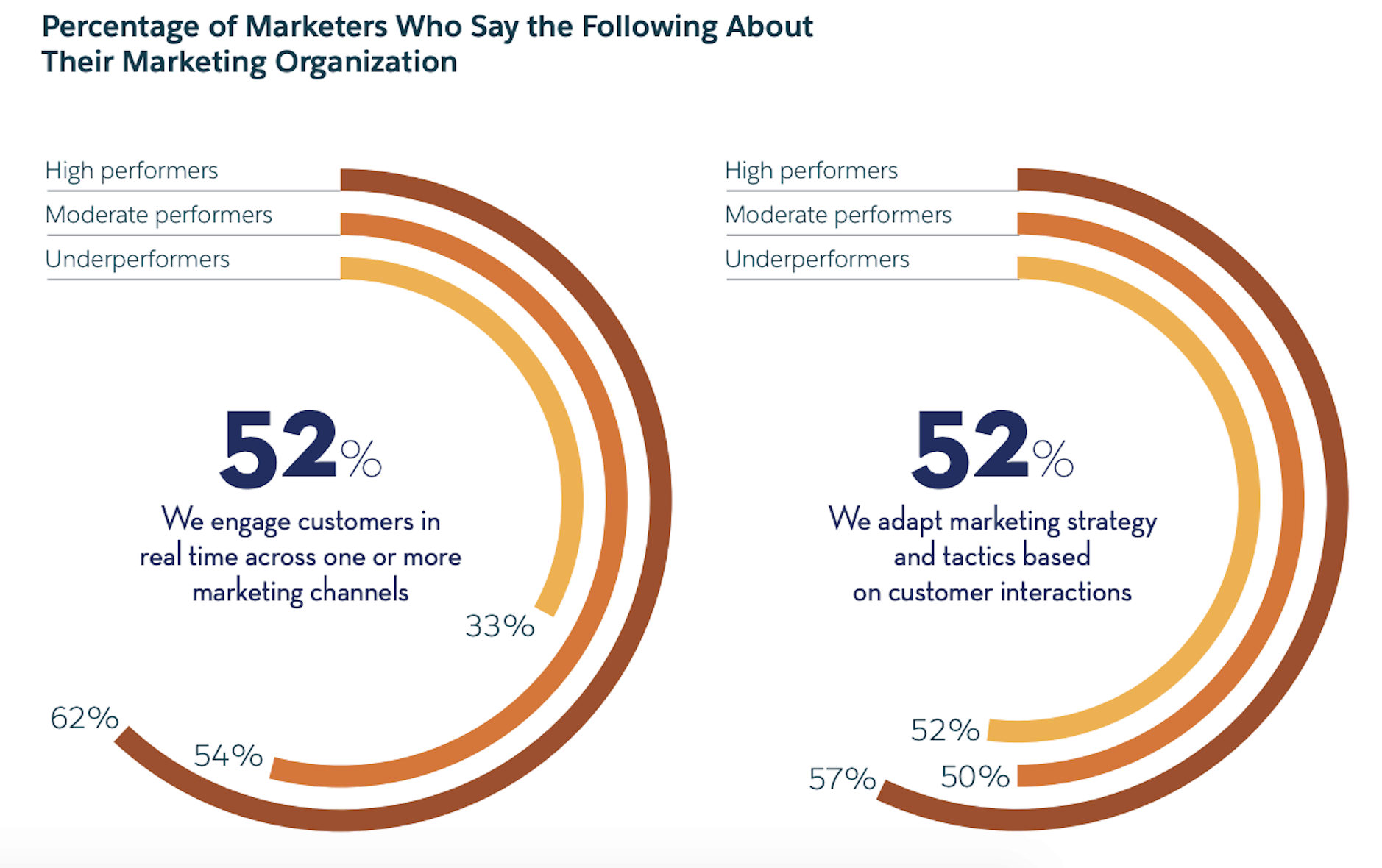
With social media as the primary place for customers to vent their frustrations about everything from your advertising to shipping time, marketers are now on the front lines of support, too.
Let's see if we can get that fixed! Please DM us your 6-letter confirmation code, the name on the reservation, and what you'd like changed. https://t.co/xSmyP7Lfyg
— JetBlue (@JetBlue) December 3, 2019
Salesforce found that only 32% of teams suppress marketing emails when a customer has an open case. (If you’re not doing this, you definitely should start now. Nothing like an upbeat sales-y email to make an angry customer even angrier ?)
That’s just one way to make sure you’re sending the right message at the right time to the right people. Because…
Personalization Works
How often do you get emails with the following? “Hey, {FIRSTNAME}”. Unfortunately, this is not uncommon.
79% of customers say they would share data in exchange for a “contextualized engagement,” which is a fancy way of saying talking to them like they’re a real person. And 88% of customers will trade their data for a personalized offer.
You don’t have my first name? I’m more than happy to give it to you for a personalized greeting! (It’s Julie, by the way).
Your customers are willing to tell you ANYTHING in exchange for being treated like a human being.
It’s that easy.
Investing in personalization is a win-win scenario because your customers demand it. And it works – 44% of marketers saw a “major improvement” in lead generation, 45% in customer acquisition, and 46% in customer retention.
To do personalization right, it’s not just about using a name in an email or responding directly on social media. You can use personalization across every channel, including your website, to create a better customer experience.
To get web personalization right, you’ll need to:
- Create a website customer journey map so you can understand exactly how your customers move through your funnel, and where you can personalize it
- Remove the roadblocks in your funnel by finding low conversion rates or convoluted processes – are you making your customer jump through hoops just to find you?
- Being personal and specific with real-time interactions to resolve customer issues quickly, leading to higher retention
- Automate and scale it ??
Not Quite “I, Robot”
Technology is what will unlock great personalization, like our example above. And more and more marketers are experimenting with artificial intelligence, augmented reality, internet of things, and other buzzword-y tech that’s been trending for the last few years.
“AI” sounds intimidating, but it really means automating some of the more menial marketing tasks like data entry, segmentation, and qualifying leads.
AI is also removing friction from the customer experience. It’s allowing for more comprehensive channel personalization, journey personalization and issue resolution. In other words, with AI customers can see what they want, get the experience that they want, and get their issues resolved in real-time.

Marketers and CX professionals are still learning what AI can do for their business. Adoption of AI has already grown by 44% since 2017 and that’s just the beginning.
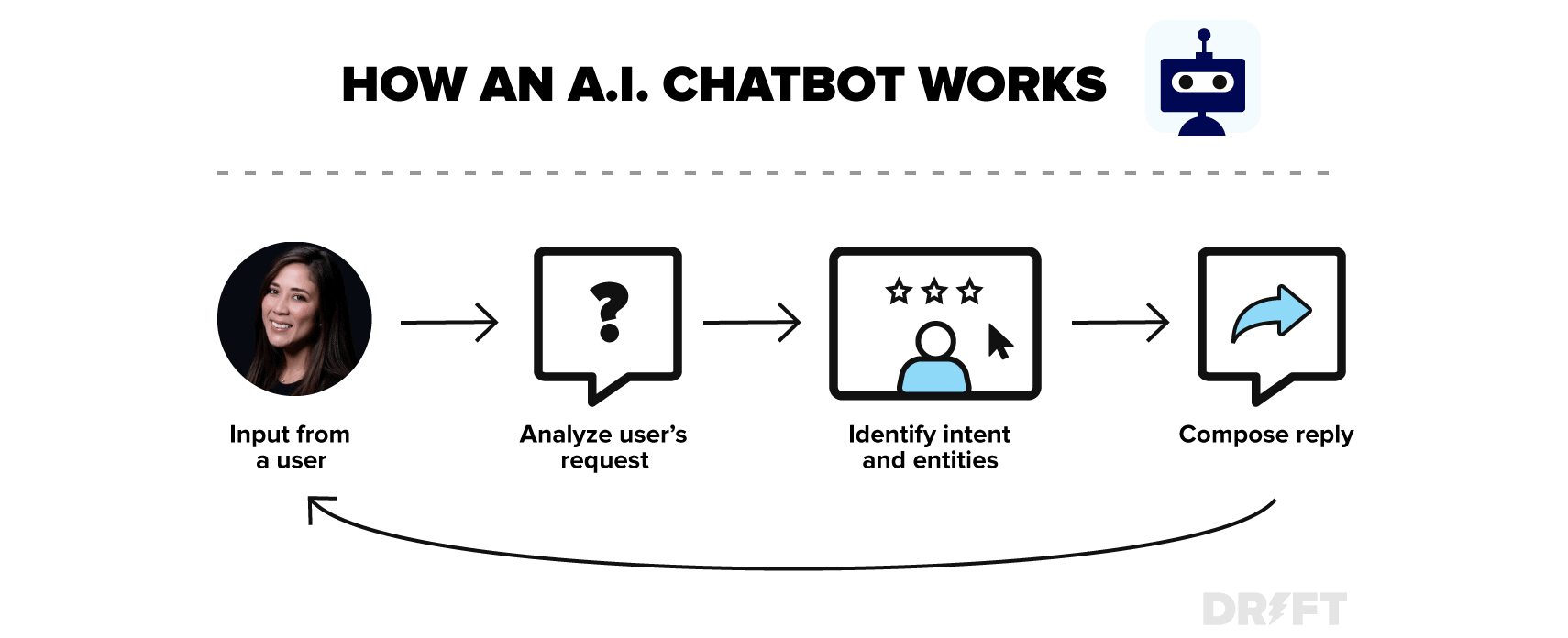
Email Marketing Still Isn’t Dead
Email appeared as the top channel for marketers looking to acquire new customers, upsell and retain existing ones, and drive customer advocacy.
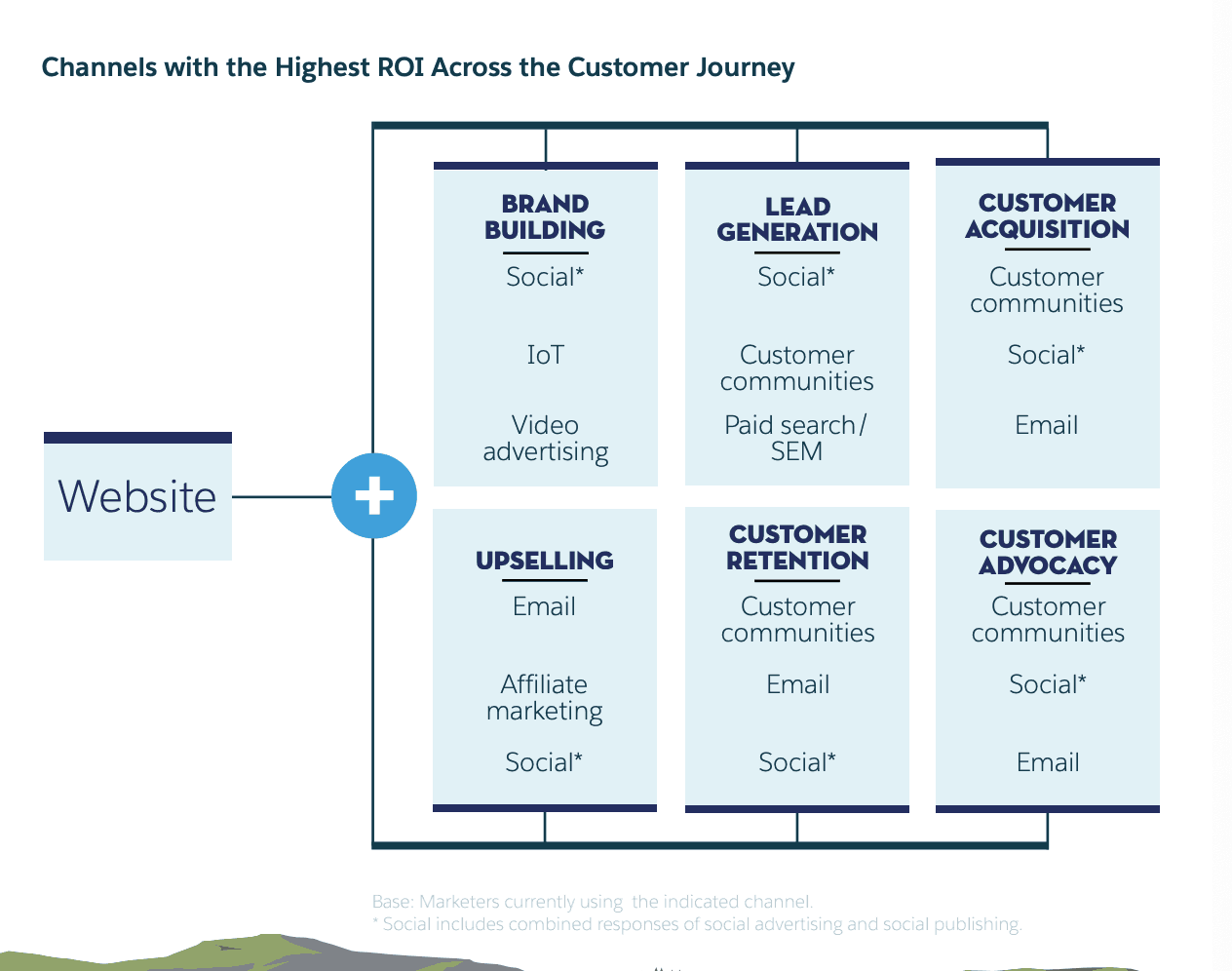
I know there are plenty of haters out there when email is concerned, but it’s still one of the best channels to get results. Email works best when you write like you talk, keep it casual and friendly, like a friend could have sent it.
Take this one for example sent as a follow up to a prospect browsing the site. It’s super short but straightforward. You can’t help but want to respond.
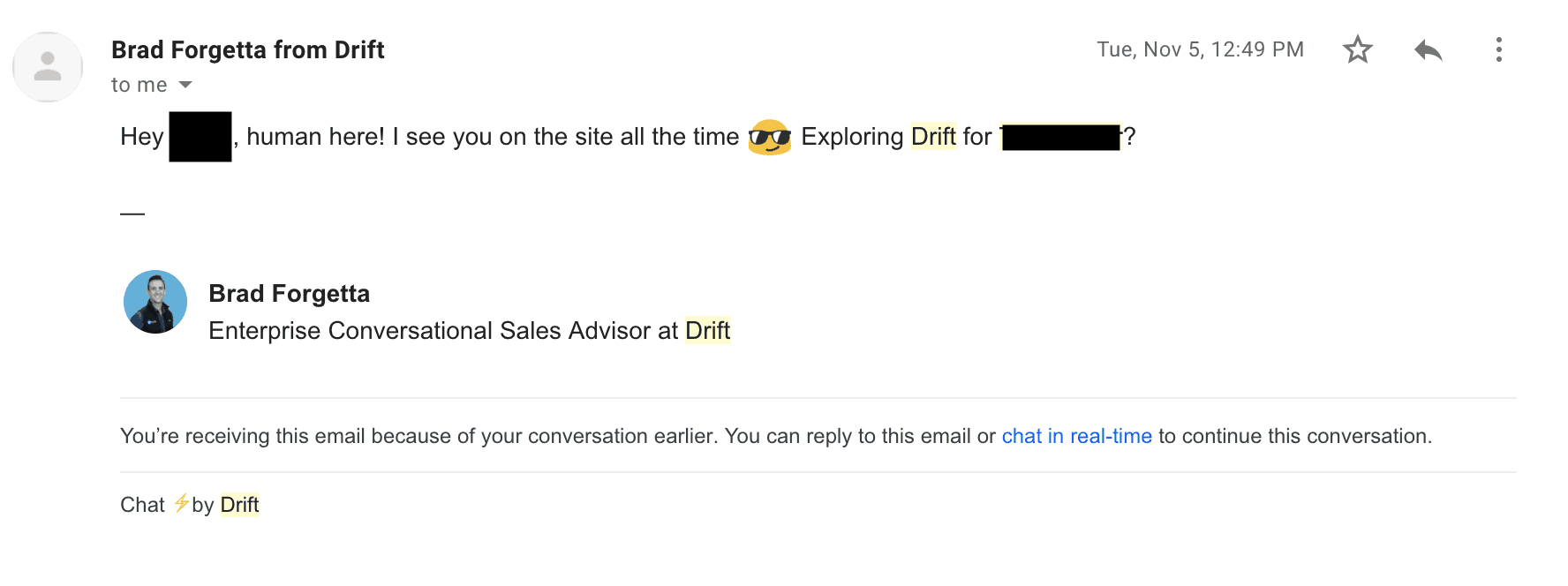
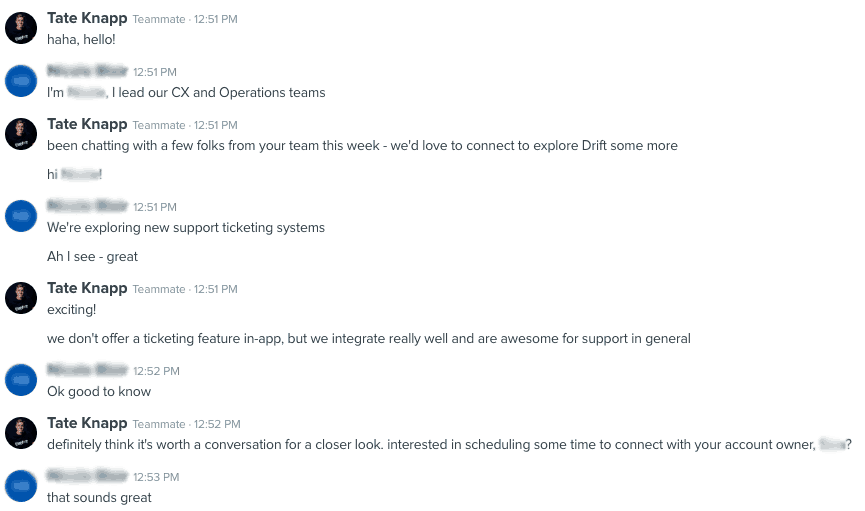
When an email feels conversational, you’re much more likely to get a response. That engagement is too good to pass up, especially when it’s targeted toward someone already interested in your brand.
And Social Media Isn’t Dead Either
“Social” in this case includes organic and paid media, but it’s still the most popular channel after email. Marketers use social at every stage in the funnel, and while marketers love to agonize over the latest social channel — TikTok anyone? — the truth is, humans are social beings.
And that’s not limited to B2B.
Social media offers connection more than any other channel. Rather than blasting out marketing messages, use social media to build a community — with your team as leaders of that community.
It doesn’t have to be fancy. You just have to be consistent and be human. Even when you’re selling something:
🗣️ Calling all B2B salespeople. Has #CyberMonday failed you? Spending your hard earned money on things that won’t help you hit your quota…
Well, do we have a deal for you.
Check it out 👇https://t.co/eRX9KhqUS7 pic.twitter.com/0F5RKdPtVE
— Drift ⚡️ (@Drift) December 2, 2019
You can also use social media to help with closing the loop! Many B2C brands are doing just that when it comes to outages, support issues, and more.
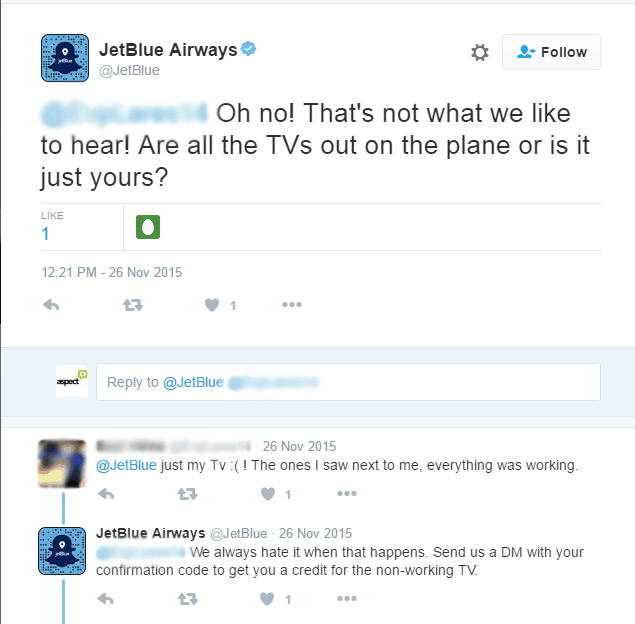
Too Many Channels?
Only 28% of marketers say they’re satisfied with their ability to engage customers across channels at scale. It’s one of the toughest things to do across a business, especially if channels are owned by different teams.
Look how many channels are on that list! Website, app, social, video, email, messaging, display, paid search, voice…and that’s not even every channel that we’re using.
Salesforce classified messages into three types:
- Dynamic – where messages evolve across channels based on customer actions
- Duplicate – where identical messages are broadcast across multiple channels
- Siloed – no coordination of messages across channels
While the majority of marketers wouldn’t fess up to siloed communications, many focus on duplicate messaging (39%), which makes sense in theory – your customers all prefer different channels, so blasting a given campaign out everywhere is more likely to catch someone’s attention.
But the most successful marketers adapt their message based on the customer, not on the channel. 36% of high performers favor dynamic messaging on average, vs. 26% of underperformers.
Conversational Marketing Is Definitely A Thing Now
Regardless of channel, time is the most important factor when driving a great customer experience.
That’s because expectations for real-time engagement encompass every channel, not just social media. Customers want to interact with you on their terms — and if you don’t deliver, they can easily walk away.
The best marketers embed the customer journey into their process so that it’s seamless:
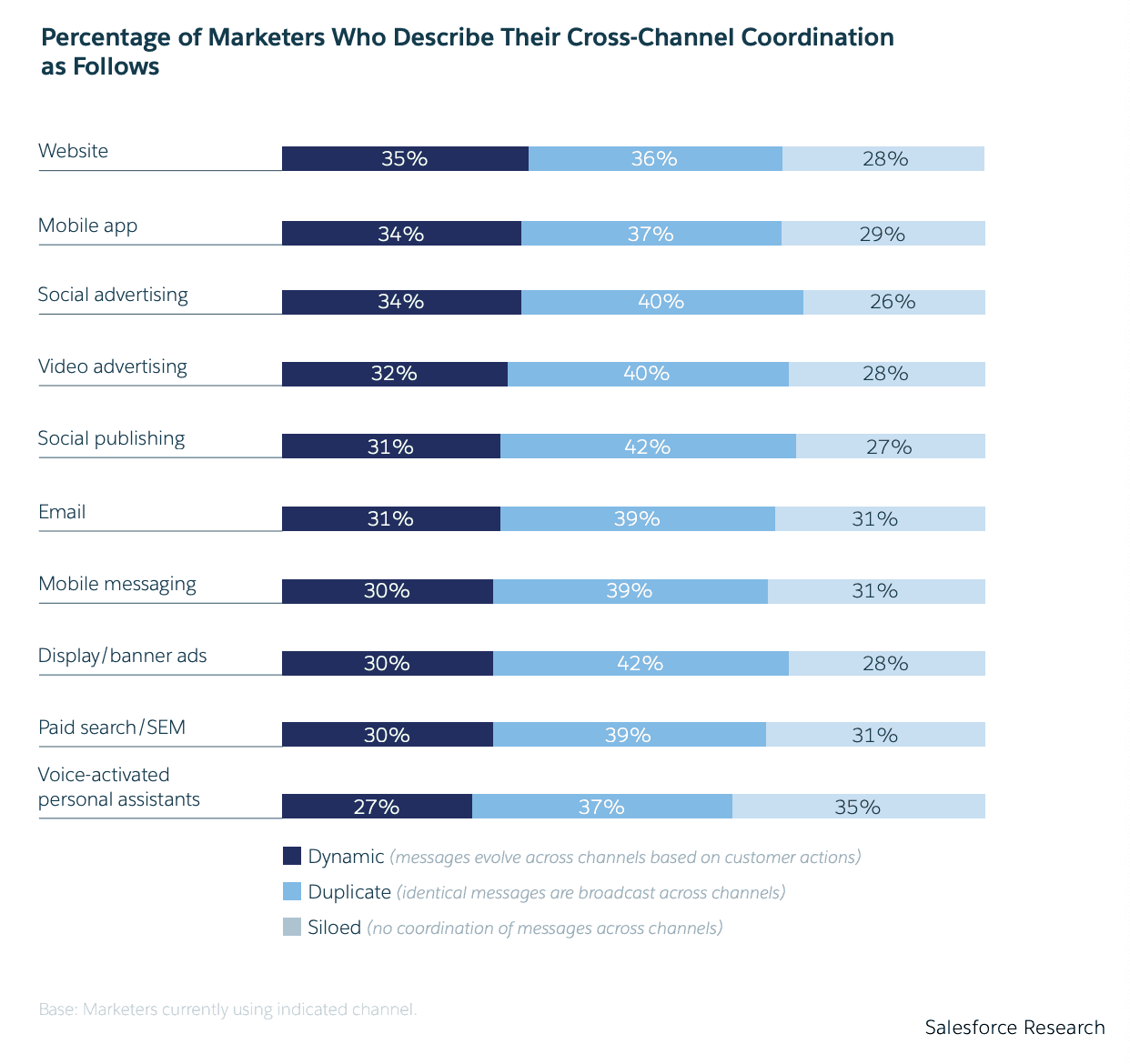
High performers are 1.9x more likely to engage customers in real-time across one or more channels, and 57% of high performers said they adapt their marketing strategy based on customer interactions.
Real-time engagement is a top priority, but also a top challenge. But it doesn’t have to be. Asas our CEO David Cancel often says, we’re in the era of “now.”
Traditional B2B tools were built for customers that were willing to wait to get things done. That’s no longer the case. Customers won’t sit around and wait for your follow-up email, or your form. They expect that you’ll meet them where they are in the sales cycle, ready with information and a smile.
I hope this recap sparked new and interesting ideas as you optimize your customer experience program in 2020 and that you’re as excited as I am about entering the Era of Experience!




